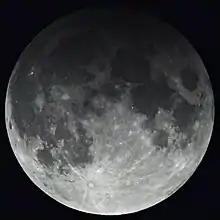| Total Lunar Eclipse December 30, 1982 | |
|---|---|
| (No photo) | |
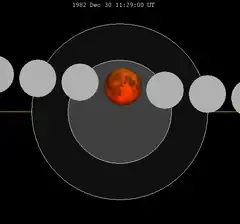 The moon passes west to east (right to left) across the Earth's umbral shadow, shown in hourly intervals. | |
| Series | 134 (25 of 73) |
| Duration (hr:mn:sc) | |
| Totality | 1:00:03 |
| Partial | 3:15:53 |
| Penumbral | 5:10:34 |
| Contacts | |
| P1 | 8:53:27 UTC[1] |
| U1 | 9:50:48 UTC |
| U2 | 10:58:43 UTC |
| Greatest | 11:29:37 TDT[2]
11:28:44 UTC [2] |
| U3 | 11:58:46 UTC |
| U4 | 13:06:41 UTC |
| P4 | 14:04:01 UTC |
A total lunar eclipse took place on Thursday, December 30, 1982. A shallow total eclipse saw the Moon in relative darkness for 1 hour 3 seconds. The Moon was 18% of its diameter into the Earth's umbral shadow, and should have been significantly darkened. The partial eclipse lasted for 3 hours and 16 minutes in total.[3] This was a supermoon since perigee was on the same day. It was also a blue moon, the second full moon of December for the eastern hemisphere where the previous full moon was on December 1.[4] Since total lunar eclipses are also known as blood moons, this combination (which would not recur until January 31, 2018[4]) is known as a super blue blood moon.[4]
Visibility

Related eclipses
Eclipses in 1982
- A total lunar eclipse on January 9.
- A partial solar eclipse on January 25.
- A partial solar eclipse on June 21.
- A total lunar eclipse on July 6.
- A partial solar eclipse on July 20.
- A partial solar eclipse on December 15.
- A total lunar eclipse on December 30.
There are seven eclipses in 1982, the maximum possible, including 4 partial solar eclipses: January 25, July 20, June 21, and December 15.
Lunar year series
| Lunar eclipse series sets from 1980–1984 | ||||||||
|---|---|---|---|---|---|---|---|---|
| Descending node | Ascending node | |||||||
| Saros | Date Viewing |
Type Chart |
Gamma | Saros | Date Viewing |
Type Chart |
Gamma | |
| 109 | 1980 Jul 27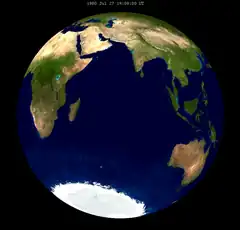 |
Penumbral |
1.41391 | 114 | 1981 Jan 20 |
Penumbral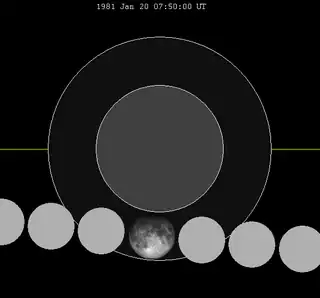 |
−1.01421 | |
| 119 | 1981 Jul 17 |
Partial |
0.70454 | 124 | 1982 Jan 09 |
Total |
−0.29158 | |
| 129 | 1982 Jul 06 |
Total |
−0.05792 | 134 | 1982 Dec 30 |
Total |
0.37579 | |
| 139 | 1983 Jun 25 |
Partial |
−0.81520 | 144 | 1983 Dec 20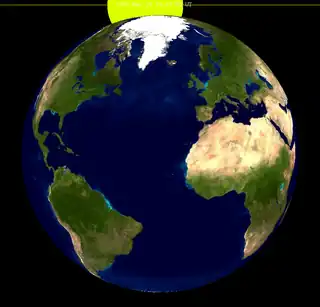 |
Penumbral |
1.07468 | |
| 149 | 1984 Jun 13 |
Penumbral |
−1.52403 | |||||
| Last set | 1980 Aug 26 | Last set | 1980 Mar 13 | |||||
| Next set | 1984 May 15 | Next set | 1984 Nov 08 | |||||
Tritos series
- Preceded: Lunar eclipse of March 13, 1979
- Followed: Lunar eclipse of January 9, 2001
Tzolkinex
- Preceded: Lunar eclipse of November 18, 1975
- Followed: Lunar eclipse of February 9, 1990
Half-Saros cycle
A lunar eclipse will be preceded and followed by solar eclipses by 9 years and 5.5 days (a half saros).[5] This lunar eclipse is related to two annular solar eclipses of Solar Saros 141.
| December 24, 1973 | January 4, 1992 |
|---|---|
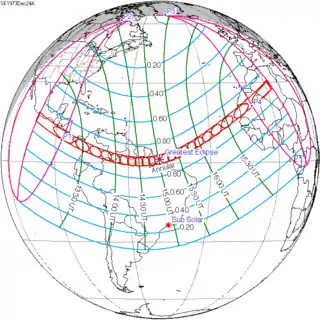 |
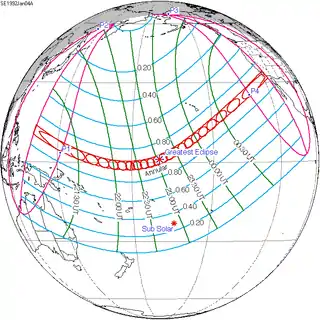 |
See also
Notes
- ↑ Fred Espenak. "Total Lunar Eclipse of 1982 Dec 30" (PDF). NASA/GSFC.
- 1 2 "Total Lunar Eclipse of 30 Dec, 1982 AD". Hermit Eclipse.
- ↑ "Lunar Eclipses in Saros Series 134". Hermit Eclipse.
- 1 2 3 Fazekas, Andrew (29 January 2018). "Rare 'Super Blue Blood Moon' Coming—First in 35 Years". National Geographic. Archived from the original on 29 January 2018.
- ↑ Mathematical Astronomy Morsels, Jean Meeus, p.110, Chapter 18, The half-saros
External links
- 1982 Dec 30 chart Eclipse Predictions by Fred Espenak, NASA/GSFC
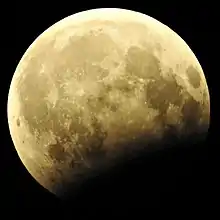
_(cropped).jpg.webp)
